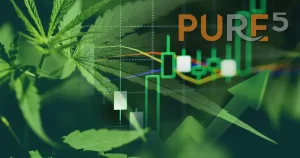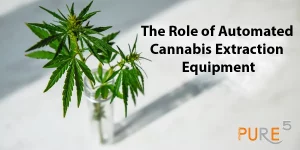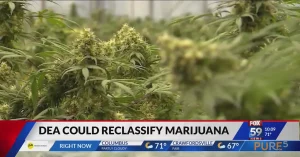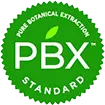Over the past few years, the legislation state to state in the US has become favorable and hundreds of farms in the US have started growing Cannabis in its 2 main forms: Hemp for CBD and Marijuana for THC. As a result there were a lot of new brands emerging from this fact. Due to its exceptional popularity you can find countless CBD/THC products that will all vary in quality, appearance, aroma and consistency. So what exactly makes cannabis oil natural?
Table of Contents
ToggleWhat are the Cannabis Oil Components?
What is Cannabidiol?
Cannabidiol is a natural compound that is found in the Cannabis Sativa plant. Cannabis Sativa is the type of flowering plant in the cannabis genus from which we get both hemp and marijuana. CBD is one of over 100 cannabinoids found in the hemp plant. It is extracted and mixed in all types of products in different states and concentrations.
What is Tetrahydrocannabinol?
Tetrahydrocannabinol stands for delta-9-tetrahydrocannabinol or Δ-9-tetrahydrocannabinol (Δ-9-THC). It is a cannabinoid molecule in marijuana (cannabis) that’s long been recognized as the main psychoactive ingredient—that is, the substance that causes people who use marijuana to feel high. THC is just one of more than 400 different active substances and 60 different cannabinoid molecules contained in marijuana, although THC is the most recognized.
What are Terpenes?
Terpenes are organic compounds that provide the aroma and flavor in cannabis and a variety of other organisms, including plants. Terpenes influence its effects by interacting with cannabinoids. Terpenes are formed inside cannabis trichomes, and their relative presence is directly affected by both the spectrum and intensity of light exposure.
Terpenes do more than provide flavor and aroma. They also support other cannabis molecules in producing desired effects. This is called the entourage or ensemble effect, and it’s the reason these aromatic compounds have become such a critical area of cannabis research.
How Does Cannabis Oil work?
THC works by attaching to the body’s cannabinoid receptors, which are found throughout the brain and nervous system. THC can be detected in the body much longer than most other drug compounds (up to 20 hours after ingestion), although the psychoactive effects only last for a few hours.
THC is also stored in body fat and organs for three to four weeks. Hair follicle testing may identify THC after even longer periods of time, around 90 days. Urine testing is often used but has been found to be an unreliable method of detection.
Where Does Color Come From?
Where Does the Color in Cannabis Reside?
There are four different parts of your plant which are capable of producing marvelous colors.
Calyxes
Calyxes make the buds. The buds are a combination of several hundred calyxes piled on top of one another, and some, or all, of them, can become a color aside from green. It is the calyxes that provide the most color in your buds. It takes a few purple calyxes to provide a red/purple ‘tint’ for example. When you look through a magnifying glass you will see the colorful pieces throughout the sample. Obviously, the greater the number of colorful calyxes, the more vibrant the color of the bud.
Pistils
The pistils, or hairs, that stick out of the buds often turn orange, red, purple or pink; even if the buds and leaves stay green. After the buds are dried, they retain some of the pistil colorings, and you’ll also see some of the color looking to get through beneath the buds.
Leaves
In certain strains, the buds stay green while the leaves change color. The result is a stunning plant, but as leaves tend to be trimmed after harvest, you won’t see much of the color on the buds. It is possible for the buds to remain the same while the leaves turn purple, for example. This phenomenon can happen when your plants are exposed to low nighttime temperatures. The leaves exposed to light turn purple while those in the shade don’t change color.
Trichomes
Experienced growers often use the ‘trichome’ method to determine when a crop is ready for harvest. Using a magnifying glass, they know that clear trichomes mean the plant isn’t ready. If the trichomes are milky white, the plant is at its highest THC content and prime for harvest. If the color changes to amber or yellow, you must harvest immediately, and the weed will provide a mellow high.
What Causes the Colors to Change?
During a plant’s life cycle, the leaves go through changes creating phytochemicals for various reasons which give plants their color, anthoxanthins (white/cream), carotenoids (yellow/orange), chlorophyll (green), lycopene (red), and anthocyanin which make up the vibrant purple and blue color in plants. Each of these compounds play a unique role in the nature of a plant’s life, as well as its survival.
Yellow strains, such as Lemon Kush, thrive in more alkaline conditions. Similarly, as the chlorophyll fades, if the plant is genetically predisposed for yellow pigmentation, the golden hues may come out later in the plant’s life, as well. If a plant has a lower number of anthocyanins, it may produce yellow, gold, and earthy hues from carotenoids, pigmentation molecules also present in carrots, autumn leaves, and tomatoes.
Reddish strains are harder to come by, but can be bred by manipulating nutrients and depriving the plant of phosphorus. The darker, even black appearing strains, are caused by an excess of pigmentation in the cannabis’ leaves. These strains are also known for more intense visuals and psychedelic highs. They usually thrive in somewhat cooler temperatures, since in warmer environments the dark, deep reds and purples may become lighter.
What are Flavonoids?
Anthocyanins and anthoxanthins belong to the flavonoid group of phytochemicals. Flavonoids are one group of a larger family of chemicals called polyphenols. Flavonoids are commonly found in fruits, vegetables, cereals, teas, and nuts. They are also abundant in cannabis plants, along with two other types of compounds we have discussed: cannabinoids and terpenes.
Beside giving plants vibrant colors, anthocyanins are also thought to have certain health benefits. According to Khoo et al., “Scientific studies, such as cell culture studies, animal models, and human clinical trials, show that anthocyanidins and anthocyanins possess antioxidative and antimicrobial activities, improve visual and neurological health, and protect against various non-communicable diseases.”
Flavonoids, including anthocyanins, have been reported to have anti-inflammatory and antioxidant effects. Anthocyanins could potentially provide a wealth of benefits. They may play a role in protecting the heart and liver, improving vision, as well as helping to prevent obesity and diabetes.
How to figure out if a product is high quality?
There is more than one answer to the question relating to the arome, color and consistency of a product. The most important to a product quality is stress caused by the process of extracting and isolating the ingredients. The most natural processes will not stress the botanicals during any of the stages of processing and will maintain the natural components and colors to repeat the original plant.
For certain, when you buy a bottle of whisky from a local department store the meaning of “natural” color is well known and established. When you buy a plant product people usually look for clear colors which are more likely chemically altered and bleached colors instead for the strain specific natural pigments we have explained above.
It is impossible to determine the concentration or quality of cannabis oil by simply looking, smelling or tasting a product. PURE5TM have been embracing their own patented technology for gentle extraction delivering the natural pure appearance of the extracts with high natural potency, without heat oxidation, chemical alteration or loss of vital components. The oils look natural and the flowers extracted do not change appearance as fragile they are.
What Makes PURE5™ unique?
Making your extraction strain specific requires a full understanding of the flower, the solvent and the process involved. Using well grown strains, extracted at room temperature with our extremely inert solvent that does not alter the original components is the most pristine way of extracting the plants.
In the last 6 years PURE5TM Extraction produced the best strain specific oils extracted with their proprietary developed nonflammable and most safely selected modified hydrocarbon method utilizing R134a removing the full spectrum of terpenes and cannabinoids in their acid and converted forms. The process known as the PBXTM (Pure Botanical Extraction) achieved large customer recognition in vapes, tinctures, dabs, and isolated terpene markets.
#
George Stantchev, PhD
602-284-8038








